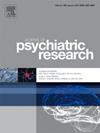精神分裂症患者的大脑结构连接与童年创伤无关。
IF 3.7
2区 医学
Q1 PSYCHIATRY
引用次数: 0
摘要
背景:精神分裂症是一种大脑连接障碍性疾病。然而,童年创伤(CT)经历是否会影响精神分裂症(SZ)患者的连接障碍,目前尚不十分清楚。利用基于网络的方法,我们研究了自我报告的CT是否能解释精神分裂症患者与健康对照组(HC)的全脑拓扑和结构连通性变化之间的额外差异:对 51 名 SZ(平均年龄 ± 标准差 44 ± 11 岁)和 140 名 HC(34.0 ± 12 岁)进行了 CT 评估。利用基于非张量的牵引成像技术,通过T1加权磁共振和弥散磁共振扫描构建大脑结构网络。对全脑拓扑结构和基于置换统计的组间差异进行了研究,并对年龄和性别进行了校正:结果:SZ 在效率、强度、聚类和密度方面均有所下降(p(范围)=4.71-18.1,p 4.0,p 结论:CT 对拓扑和密度没有影响:CT 对 SZ 的拓扑或子网络连接变化没有影响。无论诊断与否,高 CT 水平也与网络组织的任何差异无关。然而,我们的研究结果证实,SZ 既表现出网络层面的减少,也表现出子网的增加。这些发现表明,已确诊的精神分裂症患者的神经解剖学连接障碍模式可能不受 CT 的影响。未来的研究还需要进一步探讨 CT 与精神分裂症结构连接障碍之间的关联。本文章由计算机程序翻译,如有差异,请以英文原文为准。

Structural brain connectivity does not associate with childhood trauma in individuals with schizophrenia
Background
Schizophrenia is a brain dysconnectivity disorder. However, it is not well understood whether the experience of childhood trauma (CT) affects dysconnectivity in individuals with schizophrenia (SZ). Using a network-based approach, we examined whether self-reported CT would explain additional variance compared to whole-brain topology and structural connectivity changes in SZ versus healthy controls (HC).
Material and methods
CT was assessed in 51 SZ (mean age ± standard deviation 44 ± 11 years) and 140 HC (34.0 ± 12 years). Structural brain networks were constructed from T1-weighted MR and diffusion-MRI scans using non-tensor based tractography. Group differences in whole-brain topology and permutation-based statistics were examined and corrected for age and sex.
Results
SZ showed reductions in efficiency, strength, clustering and density (p < 0.01) as well as increases in path length (F(range) = 4.71–18.1, p < 0.03) when compared to HC. We also observed hypoconnectivity in a subnetwork of frontotemporal, frontoparietal and occipital regions in SZ relative to HC (T > 4.0, p < 0.001). However, we did not find that high CT levels were related to structural network differences or structural connectivity changes in SZ.
Conclusions
CT did not impact on topology or subnetwork connectivity changes in SZ. High CT levels were also not associated with any differences in network organisation irrespective of diagnosis. However, our findings confirm that SZ showed both network-level reductions and increases in a subnetwork. These findings suggest that the patterns of neuroanatomical dysconnectivity in established schizophrenia may not be influenced by CT. Future studies are needed to investigate the association between CT and structural dysconnectivity in schizophrenia.
求助全文
通过发布文献求助,成功后即可免费获取论文全文。
去求助
来源期刊

Journal of psychiatric research
医学-精神病学
CiteScore
7.30
自引率
2.10%
发文量
622
审稿时长
130 days
期刊介绍:
Founded in 1961 to report on the latest work in psychiatry and cognate disciplines, the Journal of Psychiatric Research is dedicated to innovative and timely studies of four important areas of research:
(1) clinical studies of all disciplines relating to psychiatric illness, as well as normal human behaviour, including biochemical, physiological, genetic, environmental, social, psychological and epidemiological factors;
(2) basic studies pertaining to psychiatry in such fields as neuropsychopharmacology, neuroendocrinology, electrophysiology, genetics, experimental psychology and epidemiology;
(3) the growing application of clinical laboratory techniques in psychiatry, including imagery and spectroscopy of the brain, molecular biology and computer sciences;
 求助内容:
求助内容: 应助结果提醒方式:
应助结果提醒方式:


